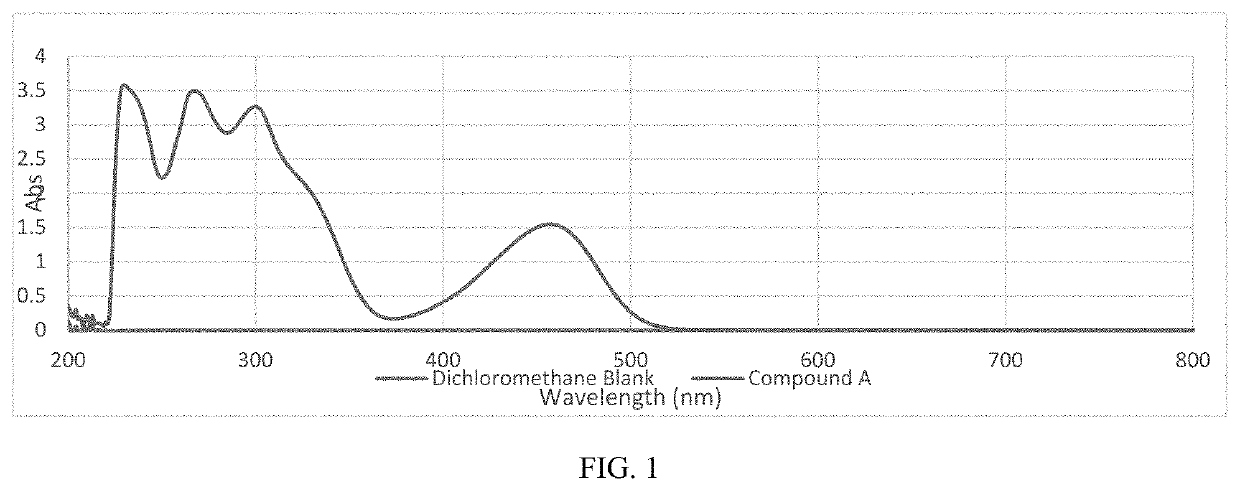Photostable mimics of macular pigment
a technology of macular pigment and mimicry, which is applied in the field of visible light absorption, can solve the problems of high barrier to the development of such products, and achieve the effect of high extinction coefficien
- Summary
- Abstract
- Description
- Claims
- Application Information
AI Technical Summary
Benefits of technology
Problems solved by technology
Method used
Image
Examples
example 1
of 2-((9-(dicyanomethylene)-9H-thioxanthen-2-yl)oxy)ethyl methacrylate (Compound A) as shown in Scheme 1
[0192]
[0193]Thiosalicylic acid (6.3 grams, ˜0.041 mole) was added over 5 minutes to 60 mL of concentrated sulfuric acid while constantly stirring the system. Phenol (18.8 grams, ˜5 eq.) was added to the reaction mixture in batches over a 30-minute period during which the temperature increased to 60° C. Once the exotherm ceased, the mixture was heated to 80° C. and then held at that temperature over 2.5 hours with constant stirring. The reaction mixture was slowly added to 600 mL of boiling water while stirring the solution. A bright yellow precipitate formed upon dilution, and the suspension was heated for an additional 10 minutes, after which it was cooled to room temperature. The solids were filtered over a fritted glass funnel. The yellow solids were washed with 3 times with 300 mL of water, dried in a vacuum oven at 50° C., and used “as is” for the next step.
[0194]A suspension...
example 2
[0198]Reactive monomer mixtures are prepared composed of 77 weight percent of the formulations listed in Table 1, and 23 weight percent of the diluent D3O. The reactive monomer mixtures is filtered through a 3 μm filter using a stainless-steel syringe under pressure.
TABLE 1Component (weight %)Ex 2mPDMS30-32SiMAA28-30DMA24-25HEMA5.5-6.5TEGDMA1-2PVP K906-8Omnirad 18700.2-0.4RB2470.01-0.03Compound A0.05-1
[0199]The reactive monomer mixture is degassed at ambient temperature by applying vacuum (40 torr) for at least 20 minutes. Then, in a glove box with a nitrogen gas atmosphere and less than about 0.1-0.2 percent oxygen gas, about 75 μL of the reactive mixture is dosed using an Eppendorf pipet at room temperature into the FC made of 90:10 (w / w) Zeonor / TT blend. The BC made of 90:10 (w / w) Z:TT blend is then placed onto the FC. The molds are equilibrated for a minimum of twelve hours in the glove box prior to dosing. Pallets each containing eight mold assemblies are transferred into an ...
example 3
[0201]A reactive monomer mixture was prepared composed of 77 weight percent of the formulation listed in Table 2, and 23 weight percent of the diluent 3M3P. Compound A was first dissolved in DMA; the resulting solution was then added to another solution containing all of the other components and diluent. The reactive monomer mixture was filtered through a 3 μm filter using a stainless-steel syringe under pressure. The reactive monomer mixture was degassed at ambient temperature by applying vacuum (40 torr) for at least 20 minutes. Then, in a glove box with a nitrogen gas atmosphere and less than about 0.1-0.2 percent oxygen gas, about 75 μL of the reactive mixture was dosed using an Eppendorf pipet at room temperature into the FC made of 90:10 (w / w) Zeonor / TT blend. The BC made of 90:10 (w / w) Z:PP blend was then placed onto the FC. The molds are equilibrated for a minimum of twelve hours in the glove box prior to dosing. Pallets each containing eight mold assemblies were transferred...
PUM
| Property | Measurement | Unit |
|---|---|---|
| Fraction | aaaaa | aaaaa |
| Nanoscale particle size | aaaaa | aaaaa |
| Nanoscale particle size | aaaaa | aaaaa |
Abstract
Description
Claims
Application Information
 Login to View More
Login to View More - R&D
- Intellectual Property
- Life Sciences
- Materials
- Tech Scout
- Unparalleled Data Quality
- Higher Quality Content
- 60% Fewer Hallucinations
Browse by: Latest US Patents, China's latest patents, Technical Efficacy Thesaurus, Application Domain, Technology Topic, Popular Technical Reports.
© 2025 PatSnap. All rights reserved.Legal|Privacy policy|Modern Slavery Act Transparency Statement|Sitemap|About US| Contact US: help@patsnap.com



